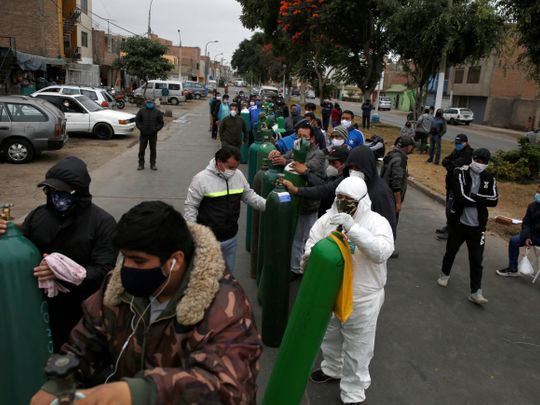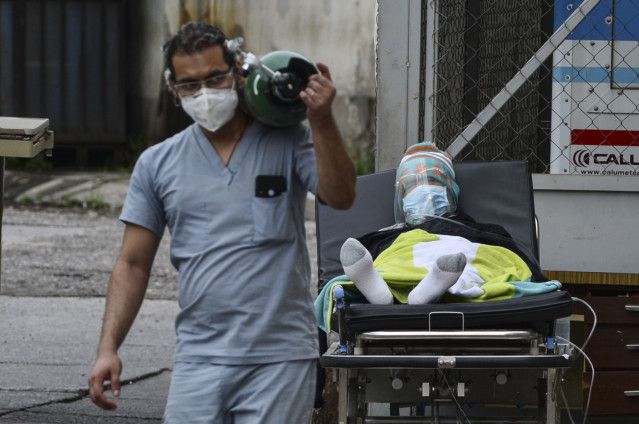
New York: As the coronavirus pandemic hits more impoverished countries with fragile health care systems, global health authorities are scrambling for supplies of a simple treatment that saves lives: oxygen.
Many patients severely ill with Covid-19, the illness caused by the coronavirus, require help with breathing at some point. But now the epidemic is spreading rapidly in South Asia, Latin America and parts of Africa, regions where many hospitals are poorly equipped and lack the ventilators, tanks and other equipment necessary to save patients whose lungs are failing.
The World Health Organisation (WHO) is hoping to raise $250 million (Dh918 million) to increase oxygen delivery to those regions. The World Bank and the African Union are contributing to the effort, and some medical charities are seeking donations for the cause.
By a stroke of luck, the WHO, Unicef and the Bill & Melinda Gates Foundation in 2017 began searching for ways to increase oxygen delivery in poor and middle-income countries — not in anticipation of a pandemic but because oxygen can save the lives of premature infants and children with pneumonia.
The organisations began ordering equipment in January, but within weeks suppliers were swamped by the sudden surge in demand created by the pandemic.
Although the machinery needed to generate oxygen is relatively simple, it must be sturdy enough to withstand the dust, humidity and other hazards common in rural hospitals in poor countries. Some companies produce relatively rugged equipment, but prices are rising and restrictions on international flights are complicating deliveries.
The machines cannot come too soon, doctors working in the field said.
In May, the Alliance for International Medical Action, or ALIMA, treated 123 Covid-19 patients in the Democratic Republic of Congo, said Dr. Baweye Mayoum Barka, the charity’s representative in Kinshasa, the country’s capital. Fifty-six of them needed oxygen, but not enough equipment was available.
“So, unfortunately, there were 26 deaths, 70 per cent of them in less than 24 hours,” Barka said. “I can’t say they were all from a lack of oxygen, but it played a role.”
ALIMA needs 40 oxygen concentrators, which filter oxygen from the air, but the agency has just eight, he said. Because it is hard to move patients from one hospital to another, some die waiting, gasping for air.
In Congo, many Covid-19 patients arrive at hospitals with critically low blood oxygen levels — sometimes as low as 60 per cent, a level at which patients must normally be put on a ventilator to survive. (Normal oxygen saturation levels are 95 per cent or more.)
One such patient was a doctor who had for a while refused to go to the hospital and instead stayed home, taking chloroquine, which is still in Congo’s national treatment guidelines.
“Then, when his condition deteriorated and he did come, just as he was nearing the COVID building, he developed convulsions,” Barka recalled. “They stopped to give him a drug for them, and he died just at the gate.”
Nigeria is also grappling with an oxygen shortage, said Dr. Sanjana Bhardwaj, Unicef’s chief of health there. Since May, hospitals in Lagos and Kano have seen a steady stream of older patients with Covid-19 symptoms who need oxygen.
Ventilators are costly
In nearly every country the virus has hit, rich or poor, about 15 per cent of all symptomatic patients develop pneumonia severe enough to require extra oxygen, the WHO estimates, but not so dire that they must be put on a ventilator.
Ventilators are rare in poor countries. They can cost up to $50,000, and patients must be heavily sedated the whole time the breathing tube is lodged deep in their airways. Also, the pressure must be constantly monitored to prevent lung damage. That requires anaesthesiologists and trained respiratory technicians, positions that many hospitals lack.

Oxygen can be delivered in two ways. Tanks contain nearly pure oxygen. For patients who need large volumes and help keeping the air sacs in their lungs open, tanks can deliver oxygen at high pressure through a mask strapped tightly over the nose and mouth.
But tanks are heavy, must be refilled at central stations and delivered by truck, and pose some risk of explosion and fire. While many poor countries have plants making industrial-grade oxygen for construction jobs like welding, it cannot be used on patients because the tanks often contain rust or oily water that could lodge in the lungs, said Paul Molinaro, chief of operations support and logistics at the WHO.
An alternative is an oxygen concentrator, which is usually the size of a suitcase or even a briefcase. Concentrators pull oxygen out of ambient air by forcing it under pressure through a “molecular sieve” filled with the mineral zeolite, which adsorbs nitrogen.
Most concentrators cost only $1,000 to $2,000. They need electricity but can run on a generator or batteries, using about as much power as a small refrigerator.
Typically concentrators can produce about 90 per cent pure oxygen. They do not deliver it under pressure, but the thin tube through which the oxygen streams can be connected to a continuous positive airway pressure machine, or CPAP, to enrich the air it blows into the lungs.
ALIMA has started a campaign, “Oxygen for Africa,” to raise money to send about 500 concentrators to six poor countries, Jennifer Lazuta, a spokesperson, said.
Unicef has ordered about 16,000 concentrators for about 90 countries, but thus far has been able to deliver only about 700, said Jonathan Howard-Brand, an innovation specialist at Unicef’s procurement centre in Copenhagen.
The WHO has ordered another 14,000, of which 2,000 have been delivered and 2,000 are in transit, Molinaro said.
He and Howard-Brand described severe delivery problems created by the epidemic, including delays of up to five weeks. When possible, the aid agencies ship through the World Food Program, which has dozens of planes. But the concentrators must compete for space with shipments of food, personal protective gear and other life-saving goods.
Also, some countries are far from cargo hub cities, while others restrict all flights, even those containing aid, for fear of the virus being introduced.
“We need more planes in the air,” Howard-Brand said.
Unicef is also buying tens of thousands of pulse oximeters, fingertip devices to measure blood-oxygen saturation.
In deciding how much equipment to buy, the aid agencies are, to some extent, flying blind. As New York state learnt when it was desperately collecting ventilators in March, how great the need will be is unpredictable.
Younger Covid-19 patients and those without other health problems often survive without supplemental oxygen. Populations in Africa skew younger, because vaccination and anti-malaria campaigns over the past two decades have saved many children who otherwise would have died. Wide swaths of older Africans died of Aids before HIV therapy became widely available in the mid-2000s.
(It is still unclear whether being on HIV treatment increases risks of death from Covid-19, according to the Centres for Disease Control and Prevention. But UNAIDS, the UN programme fighting the disease, worries that lockdowns and border closings will disrupt supplies of HIV medicines, which would undoubtedly put HIV patients at high risk.)
The agencies seek advice from other aid personnel in each country to estimate how much equipment is needed, Molinaro said. If he had more money and time, he added, he would concentrate on ways to increase supplies of tanked oxygen, which is dangerous to ship and so must be produced on site.
In recent years, some public-private partnerships have sprang up to do that. In East Africa, for example, an aid organisation, Assist International, set out several years ago to break local corporate monopolies producing medical oxygen that many public hospitals in Africa could not afford.
With equipment supplied by the GE Foundation and money from Grand Challenges Canada and other donors, Assist now has a network of oxygen-making plants in Rwanda, Kenya and Ethiopia.
The UN’s oxygen-concentrator procurement effort, begun in April, was a natural extension of the UN’s Oxygen Therapy Project, which began in 2017 with Gates Foundation support in an effort to save babies and children.
By January, the project had found four manufacturers — two in China and two in the United States — whose machines could stand up to harsh conditions and which could add voltage stabilisers to prevent damage from power spikes, which are common in the electrical systems of poor countries and anywhere that relies on generators for power.
The agencies were just beginning to place orders when the pandemic began.
“Our timing was immaculate,” said Howard-Brand, who helped write the specifications for the new machines. “Now maybe the market will open up.”
Why Oxygen is precious in poor countries
Soaring demand for oxygen prompted by the coronavirus is bringing out a stark global truth: Even the right to breathe depends on money.
In wealthy Europe and North America, hospitals treat oxygen as a fundamental need, much like water or electricity. It is delivered in liquid form by tanker truck and piped directly to the beds of coronavirus patients. Running short is all but unthinkable for a resource that can literally be pulled from the air.
But in poor countries, from Peru to Bangladesh, it is in lethally short supply. Across sub-Saharan Africa, oxygen is a costly challenge for government-funded medical facilities such as Guinea’s Donka public hospital in the capital, Conakry.
The hospital’s planned oxygen plant has never started up. So instead of piping oxygen directly to beds, a second-hand pickup truck carries cylinders over potholed roads from Guinea’s sole source of medical-grade oxygen, the SOGEDI factory dating to the 1950s. Outside the capital, in hospitals and medical centers in remote villages and major towns, doctors say there is no oxygen at all.
In Bangladesh, the lack of a centralised system for the delivery of oxygen to hospitals has led to a flourishing market in the sale of cylinders to homes. In Peru, the president has ordered industrial plants to ramp up production for medical use or buy oxygen from abroad. He allocated about $28 million for oxygen tanks and new plants.
Yet until 2017, oxygen wasn’t even on the World Health Organisation’s list of essential medicines. In vast parts of sub-Saharan Africa, Latin America and Asia, that meant there was little money from international donors and little pressure on governments.
“Oxygen has been missing on the global agenda for decades,” said Leith Greenslade, a global health activist with the coalition Every Breath Counts.
The issue got more attention after British Prime Minister Boris Johnson narrowly survived coronavirus, crediting his recovery to the National Health Service and “litres and litres of oxygen.” But Johnson is a prominent figure in one of the world’s wealthiest countries.
Unlike for vaccines, clean water, contraception or HIV medication, there are no global studies to show how many people lack oxygen treatment — only broad estimates that suggest at least half of the world’s population does not have access to it.
In the few places where in-depth studies have been carried out, the situation looks dire. In Congo, only 2 per cent of health care facilities have oxygen; in Tanzania, it’s 8 per cent, and in Bangladesh, 7 per cent, according to some limited surveys for USAID.
Everywhere that oxygen is scarce, pulse oximeters to measure blood-oxygen levels are even scarcer. By the time lips turn blue, a frequent measure used, a patient is usually beyond saving.







